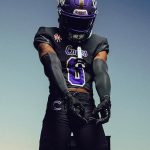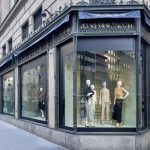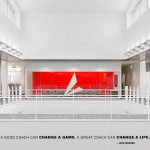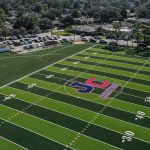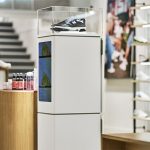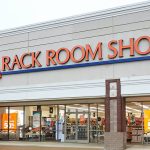Joseph Bentvelzen, founder of Shoes-n-Feet, certainly knows all about fixing aching feet, but his initial training came from fixing broken shoes. In 1932, his father, Jan, opened a shoe repair store in Holland with an innovative service of free pick-up and delivery. After emigrating to the U.S., Joseph adapted the “While You Wait” service when building a chain of 16 shoe repair stores in the Pacific Northwest.
However, Bentvelzen soon found that the shoe repair business was becoming antiquated due to the continuing arrival of cheaper and longer-lasting shoes. But the entrepreneur also began noticing that his customers kept bringing back the same shoes for repair. As it turned out, those customers had closets full of shoes, but only a few that actually fit or felt comfortable.
“Footwear technology kept getting better, and more and more vendors with quality shoes were becoming available, but the shoes werent getting on peoples feet,” says Chris Bentvelzen, the founders son and Shoes-n-Feets head buyer and director of franchise sales. “So, we looked at how to solve that disconnect.”
That spawned the idea for The business now boasts two company-owned stores and 10 franchised locations in Washington and California. The stores-which each average 1,500 to 2,400 square feet-are located in strip malls. About 55 percent of the product mix is comprised of comfort shoes, 30 percent is athletic footwear, 10 percent is over-the-counter arch supports, and 5 percent consists of socks and accessories. Best-selling brands include Brooks, New Balance, Asgi, Aravon, Naot and Munro. About 80 percent of Shoes-n-Feets customers are women.
More so than other comfort shoe retailers, Shoes-n-Feet enmeshes itself with the local medical community. Podiatrists own and invest in the stores, hold positions on Shoes-n-Feets board, and play a hands-on role in training Shoes-n-Feets Certified Shoe Fitting Specialists at the retail level. A director of medical community relations on the companys management team dedicates her time to building relationships at a national level with the medical community, and also to training its staff and franchisees at the regional level. A medical referral wall in each store displays the business cards of nearby podiatrists. And while many comfort shoe stores are increasingly making and selling custom orthotics to treat foot problems, store associates regularly send customers to local podiatrists.
Due to this commitment, a new Shoes-n-Feet store typically receives 60 to 70 percent of its business from medical referrals, ranging from podiatrists to physical therapists, orthopedic surgeons, and general practice doctors. An existing store receives 20 to 30 percent of its business from first-time medical referrals. The company also generates business from repeat customers and word-of-mouth due to its strong customer service. The chain does no formal advertising.
The younger Bentvelzen believes the referrals-and customer word-of-mouth-only comes because of Shoes-n-Feets focus on foot care education at the store level. Franchise owners undergo 160 hours of training on such key topics as customer service skills, foot anatomy, foot pathology, foot ailments, and shoe construction. The training includes visiting podiatry offices and orthotics labs to see inserts being made. The final leg includes a written exam lasting between three-and-a-half to five hours, and a hands-on customization exam.
Like its corporate store employees, all Shoes-n-Feet franchisees are taught the importance of visiting doctors offices and putting together visitation schedules. (Bentvelzen himself continues to meet with two to three doctors a day.) At the store level, the sales staff typically faces a 90-day training period on foot care and customer service principles before they are allowed to sell shoes on their own.
“These doctors trust us to have the highest level of training, the best possible shoes to fit their patients needs, and over-the-counter arch supports. And our staff is very understanding,” says Bentvelzen.
Of course, the arrival of better-fitting shoes has made the job much easier.
“When we first started, it was a challenge just to find shoes to put in our stores,” recalls Bentvelzen. “With my background in shoe repair, I saw shoes from the inside out [and saw] how shoes were constructed. So when I used to go to the shoe shows two times a year, my first question was, Does it have a removable foot bed? And that would probably cancel out 80 to 90 percent of the shoes off the bat. So I spend hours and hours looking at shoes and tearing shoes apart just to find out if they are going to match what I need.”
Bentvelzen adds, “The shoe has to fit. I could care less what it looks like. If the shoe doesnt fit, its not going to work for my store. Thats what my customers and my medical community expects out of me.”
Nevertheless, fashion certainly counts, Bentvelzen admits. Studies continue to show that 80 percent of Americans are living with foot pain, which can often be quickly solved by finding a properly fitting shoe. And a primary reason people keep wearing uncomfortable shoes is because the footwear industry continues to heavily promote fashion over fit and comfort.
“People want to have the latest looks and the pointy toes and the high-heeled shoes,” laments Bentvelzen. “Its a challenge for us to always get more fashion into the shoes.”
While the Euro-comfort trend certainly brought a host of quality shoes to the market, many female consumers-particularly those under 30-didnt find the boxy toes and thick soles too attractive, Bentvelzen notes. Even many older women were looking for dressier and more professional looks. And those over the age of 65 typically couldnt wear the Euro-comfort shoes because they were too heavy. However, Bentvelzen notes that Shoes-n-Feet has finally started to find some dressier styles, which are being added to the mix this Fall.
“Theyre not going to be your high-fashion shoes, but theyll be better-looking, more dress-style shoes that more people will like and enjoy, but will still fit,” says Bentvelzen.
Another primary reason that people continue to wear ill-fitting shoes is because most dont get sized during their adult years, despite the fact that feet change over time. Bentvelzen suggests that many Americans are simply naive about how shoes should fit and feel, and part of this is due to a fall-off of customer service at shoe retailers. The self-service model exemplified by chains such as Payless ShoeSource and DSW has become more prevalent, plus many full-service stores are often staffed by young, untrained sales people. Even stores that claim to be committed to fit might have one or two employees qualified to properly fit a customer, but the skill level drops off dramatically after that.
“You need every single one of your staff members to be at the highest level, and thats what Shoes-n-Feets philosophy is all about,” says Bentvelzen. “[We focus on] how we can help each customer that comes in the door, and give them the best service, the best knowledge, and the best fit possible.”
Indeed, Bentvelzen believes running specialty retailers could do a much better job of partnering with the local medical community, because these doctors more often than not point consumers to running shoes.
“If you have a good, knowledgeable staff and good-quality products, then partner up with a member of the medical community,” advises Bentvelzen. “It’s easier, quicker and more profitable. I probably have a 98 percent conversion rate on my medical referrals. If you could sell to 98 percent of the people who came into your store, you would never change your business model!”
Bentvelzen likewise believes that vendors would benefit by marketing and partnering more with members of the medical community.
“Many of the medical professionals want to show patients the styles of shoes that we carry and what are good for their feet,” says Bentvelzen. “One of the biggest things I hear from patients is that they thought that all my shoes were going to look like Frankenstein shoes, and that we actually have cute shoes. If medical professionals had shoes, the patient would not have to worry about the styles and would more likely come in to purchase those styles of shoes.”
Bentvelzen also believes that vendors could do a better job of listening to retailers. Many shoes that dont fit often wind up being sold again next season. In the past, Bentvelzen has worked with Brooks, New Balance, Aravon, Dunham, Naot, and Bite in coming up with new design ideas.
“I feel that my knowledge of shoe repair, foot ailments and proper fit has resulted in some great-fitting shoes,” says Bentvelzen. “It seems like these manufacturers continue to go back to the same people, and you get the same ideas and same concepts over and over. But there are different ways of doing it. [Retailers] oftentimes know what is missing in the industry or how to make shoes better.”
Looking ahead, Shoes-n-Feet might open one company store this year, but there are no plans to add franchise doors. Given the challenging economic climate, management is pausing after years of expansion-but Bentvelzen still sees big opportunities down the road.
“I believe our concept is too good not to [expand],” says Bentvelzen. “We want to make sure that we redefine or tweak things, but our concept is fantastic. I have colleagues that are doing three times the amount of business dollar-wise, but Im making more money than they are. I think the industry average is about a 2 percent net profit, but were in the high-teens to low-20s. It’s a much more profitable concept.”
Bentvelzen believes his concept will only become stronger as Americans slowly recognize the importance of shoes that fit correctly.
“Not having the proper foot health affects everything,” says Bentvelzen. “It affects your mentality. If youre in pain, youre grumpy. Youre taking it out on your wife or your kids. You gain weight and it causes other problems. Your feet are so important to your overall health.”


